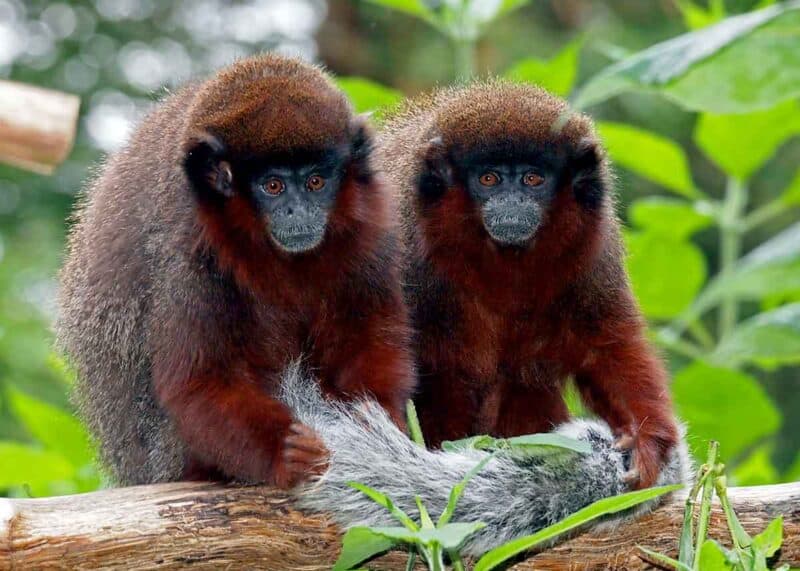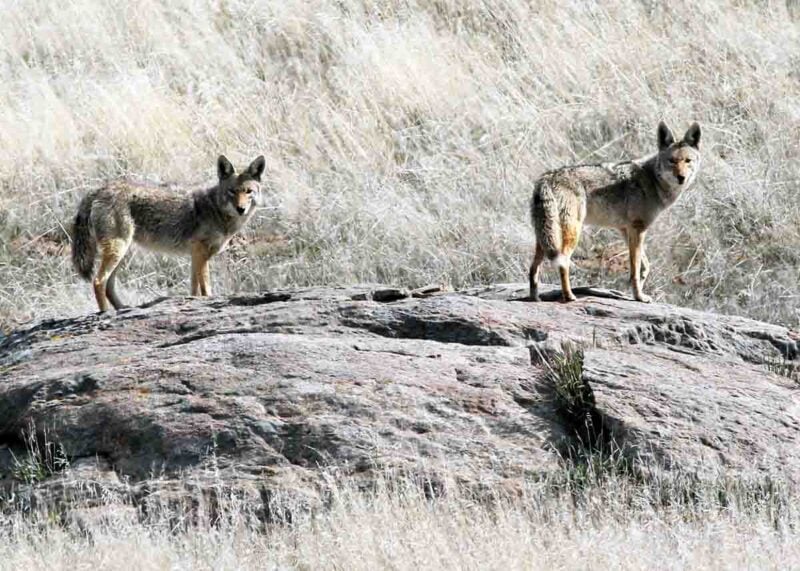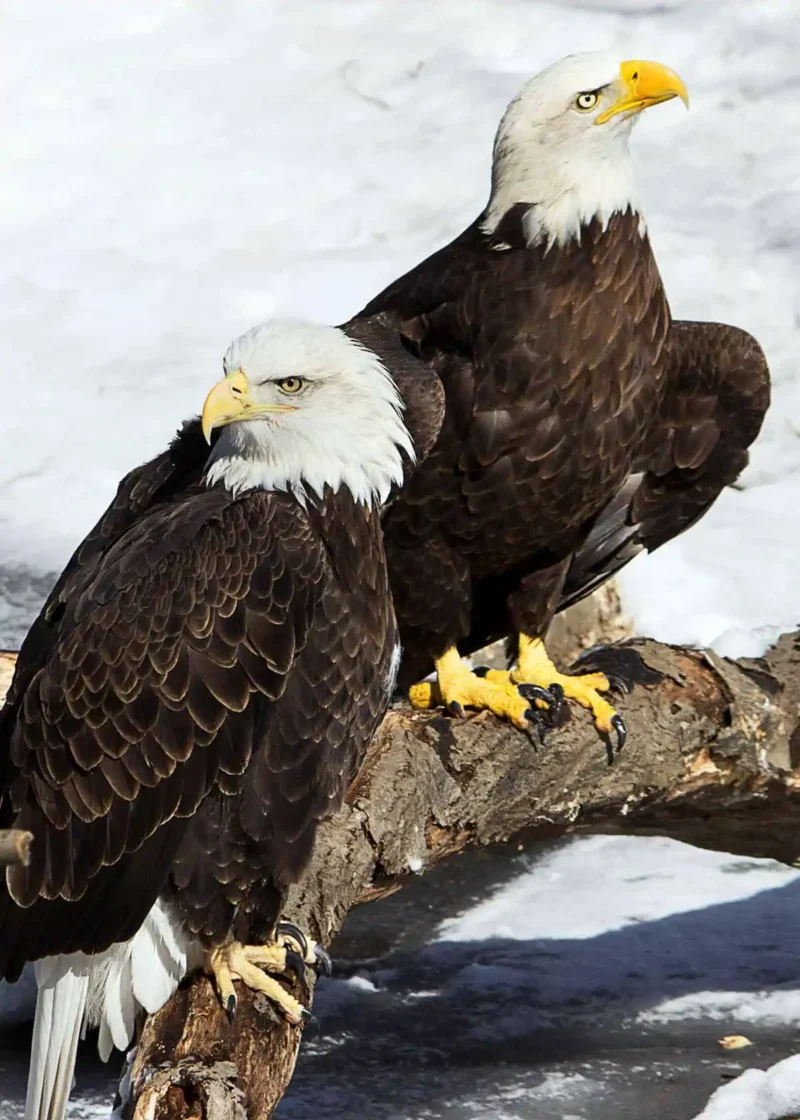Love is strange and wonderful, and that is true when it comes to any species. However, when it comes to the animal kingdom, very few animals mate for life.
Animals that mate for life include wolves, swans, beavers, macaws, and dik-diks. Some surprising monogamous animals are two lizard species, a tiny shrimp species, and an Asian otter species.
Here’s the full breakdown of my favorite monogamous animals.

This is part of my series of amazing animals. Learn more about weird and scary animals.
Table of Contents
Animals that Mate for Life
Look at our list of monogamous animals to learn more about the species with the most devoted mates.
11 Mammals That Mate For Life
Here are some of the most prominent mammals that mate for life!
1. Titi Monkeys
Even though most primates are polyamorous, titi monkeys are another species that are monogamous in the wild.
These South American primate couples raise their young in small family units, keeping their young with them even after several additional mating cycles.

2. Foxes
Several subspecies of foxes mate for life, including red and gray foxes.
Litters generally have four of five kits, and both parents help raise the young. The mother stays with the young while the father hunts for the small family until the kits are old enough for the mother to help hunt.
Foxes are very vocal creatures and can make a wide range of sounds.
3. Wolves
Most wolves don’t mate each year. Usually, only mated alpha male and female pairs produce young for their pack.
Wolf pairs are very affectionate with each other, frequently touching, grooming, and sleeping beside each other. A wolf pack’s territory can range from only 25 square miles to over 1000 square miles.
4. Small-Clawed Otters
While most North American otters are polyamorous and will take multiple partners in only one mating period, most species of otters in Europe and Asia are monogamous.
Small-clawed otters live in the mangroves of Eurasia and are very devoted to their mate. Couples of this species are together from sexual maturity until death.
Each new litter stays with the parents until the next batch comes along.

5. Beavers
Beavers are a fascinating case, and they display many human-like bonding patterns.
They are typically monogamous, but some individuals within the species choose to end long-term bonds. Beavers who desire a new partner often stick around to help raise their young until they are two or three years old, raising half-siblings in family groups of three parents.
These rodents are the largest in North America. Beavers consume the soft parts of the trees as food.
6. Yellow-Winged Bat
Yellow-winged bats choose their mates for life, but unlike many monogamous species, the mother provides most of the care and foraging for herself and the young after birth.
While the fathers may choose to help raise the young, yellow-winged bat mothers can carry their young immediately after birth to search for food and to provide for themselves and their young.
7. Prairie Voles
Prairie voles are some of the most devoted animals to their mates on the planet.
These small rodents share child-rearing responsibilities, build their homes together, and split food-finding duties.
While most of the other animals on this list stay with their partner for life, they would choose a new one if their mate were to die. But prairie voles often refuse a new mate if their first mate dies.
8. Gibbons
Like titi monkeys, gibbons are an exception to the rule that most primates are polyamorous.
Gibbons stay together across multiple mating seasons. However, they often split up during periods of the year when there are no young for the couple to care for.
While most people assume that gibbons are a type of monkey based on their appearance, this primate is actually a type of ape.

9. Coyotes
Some coyotes form packs like wolves. In these situations, only the alpha male and female form mating bonds.
However, inside or outside of a pack, coyotes are monogamous when they form mating bonds. Most parents welcome their children to stay as long as the environment provides enough food to support the family.
10. Dik-diks
Dik-diks are as loyal to their mates as they are adorable.
While these tiny antelopes are devoted to their lifemates, they aren’t the kindest parents. Adult dik-diks will drive their adolescent children out of their territory before the next mating season.
Dik-diks got their name because the sound that the females of their species make sounds like “dik.“
11. Macaroni Penguins
Macaroni penguins might not sing songs or give pretty stones to their mates as other penguin species do, but they are excellent at staying by their chosen partner’s side.
When these penguins have laid their egg, one parent watches the egg while the other goes off for days or weeks to hunt for food.
There is some debate as to whether penguins are actually monogamous. While everyone agrees that they often commit to multiple breeding seasons, some feel that these relationships don’t last beyond that.
10 Birds That Mate for Life
Here are the most prominent birds that mate for life!
1. Barn Owls
Barn owls frequently bond into monogamous relationships. However, most female owls can only go through two breeding cycles.
Thrifty couples reuse nesting sites that other couples created and abandoned, choosing to repair old nests rather than start from scratch.
2. Geese
Geese mate for life. They migrate across the continent not only to reunite with their mate but also to return to the exact same mating site each year.
Geese choose monogamy for their partners, but they choose an “it-takes-a-village” approach to raising their young. Parents typically raise their goslings alongside other couples’ children in a large group.
3. Pigeons
Pigeons are monogamous birds that won’t take a new mate unless their previous mate dies.
The birds reuse the same nest site each year but add to it, resulting in an ever-growing nest.
While many people think of pigeons as pests nowadays, there was a time when pigeons were very valuable creatures. Pigeons like roosting in the same few spots, so they made excellent methods of letter transportation.
4. Morning Doves
These monogamous birds lay eggs more frequently than most other North American birds and can have six clutches of eggs each year.
Both parents keep their eggs warm and provide food for their young, keeping mother and father morning doves busy year-round.
5. Swans
Swans are loyal birds who form a close mating bond.
While most birds are monogamous, they will find a new one if their chosen mate dies. However, many swans will forego a new mate and remain alone if their partner passes on.
These birds are some of the largest waterfowl in North America, with the trumpeter swan subspecies coming at the largest.
6. Turkey Vultures
Turkey vultures mate for life and have one clutch of eggs each year.
These monogamous birds are native to North America. Their eggs are large and have brown and purple spots.

7. Bald Eagles
Bald Eagles are monogamous birds making a comeback in North America in recent years.
Frequent DDT use caused many bald eagle eggs to be too thin to survive in the 1970s, but since the decline of DDT usage, it’s a common site to see bald eagles nesting along rivers.
8. Albatrosses
Albatrosses are birds that typically mate for life. However, despite how dedicated these birds are, if they cannot find their mate when the proper season comes around, some choose to “remarry.”
While these rates are very low, it seems albatrosses have difficulty maintaining long-distance relationships.
9. Sandhill Cranes
Sandhill cranes mate for life, attracting this partner by performing a flashy dance display.
These birds aren’t afraid to use props, like plants and sticks, to make their dances more extravagant.

10. Macaws
Macaws are another monogamous bird species.
These beautifully colored creatures are tactile with their mates and spend a lot of time grooming each other as a form of bonding.
Typically, macaw mothers hold sole responsibility for keeping their eggs warm, while the father’s job is to ensure that the mother has plenty of food.
Here are more birds that mate for life.
Here’s more about animals that mate for life.
2 Reptiles That Mate for Life
Here is a taste of some of the reptiles that mate for life!
1. Shingleback Lizard
Shingleback lizards mate for life but don’t spend most of the year together. These lizards are anti-social creatures and typically stay on their own outside mating season.
These lizards don’t lay eggs, but rather the eggs hatch inside the mother, and she gives birth to live young.
2. Gidgee Skinks
The gidgee skin is an Australian reptile that practices monogamy. However, couples don’t mate every year. Only approximately 3 in 4 couples have a brood of children in any given year.
2 Insects That Mate For Life
Here is a taste of some of the Insects that mate for life!
1. Termites
While termites aren’t most people’s first thought regarding creatures that mate for life, most subspecies are monogamous.
Like wolves and coyotes, only the respective male and female leaders mate, and the king and queen of the colony are the only ones who reproduce.
If any other couple forms within a termite colony, they go off on their own to start a new group.
2. Taiwanese Giant Cockroach
Most people aren’t very fond of cockroaches. However, this subspecies isn’t the kind that haunts kitchens.
Taiwanese giant cockroaches feed on wood. Couples mate for life and settle down inside rotten timber, raising their young inside a stable food source.
1 Crustacean That Mates For Life
Here is a taste of some of the crustaceans that mate for life!
1. Caridean Shrimps
Typically, marine life doesn’t favor monogamy. However, the rates of mating-for-life go up dramatically when it comes to crustaceans with specific food needs.
One sea invertebrate species that mates for life is the caridean shrimp.
Caridean shrimp live inside oysters, making it easier for them to remain with their mate inside their food source and raise their young.
Your Turn
Which animal couple do you love the most? Did I miss some animals that mate for life? Please let me know in the comments!
Drew Haines is an animal enthusiast and travel writer. She loves to share her passion through her writing.
She graduated high school at sixteen and started her own business, Everywhere Wild Media. And she runs Everywhere Wild and JustBirding. She also guest blogs on Storyteller.Travel
She lived in Ecuador for 6 years and explored the Galapagos Islands. Currently based in N.S., Canada.
